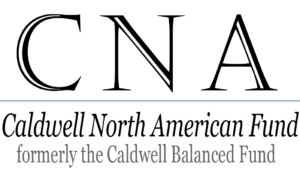Market Commentary
For the first quarter of 2023 (“1Q23”), the Caldwell North American Fund (“CNA” or “Fund”) gained 2.0% versus a gain of 6.0% for the Fund’s benchmark, which comprises an equal blend of the S&P 500 Total Return Index and the S&P/TSX Composite Total Return Index.
In Canada, Information Technology (“IT”), Materials, and Consumer Staples were the top-performing sectors, whereas Energy, Healthcare, and Financials were the underperformers. In the U.S., IT, Communication Services, and Consumer Discretionary were the top-performing sectors, whereas Energy, Financials, and Healthcare were the underperformers. IT was a top-performing sector that Canada and the U.S. both had in common during the quarter. There were two primary drivers behind its outsized performance: 1) At the beginning of this year there was an abrupt shift towards a risk-on sentiment in the market due to heightened hopes that inflationary pressures are abating as the U.S. Consumer Price Index (“CPI”) data published in January demonstrated that inflation had declined for the sixth consecutive month in December 2022. Subsequently, investors expected federal banks to adopt a less hawkish stance, leading to increased expectations of smaller rate increases later in the year. This, combined with better-than-feared corporate earnings, fueled the perceived probability of the economy avoiding a classic recession and instead experiencing the less destructive soft-landing scenario, which would consist of a gradual slide in economic conditions without a severe spike in unemployment or a catastrophic decline in consumer spending. As a result, the longer-duration stocks (i.e. stocks that benefit from lower interest rates), such as the typical constituents of the IT sector, which posted some of the worst declines last year, as a consequence of lacking quality earnings to weather a possible recessionary environment, experienced a sharp turnaround in their stock prices. 2) The banking crisis in the U.S. began on March 9th and ultimately led to the failure of a few large regional banks. The Federal Reserve was swift in its efforts to contain the crisis and given the potential ripple effects of tighter lending standards, investors began to price-in the end of the rate hike cycle much sooner than just before the crisis. To that end, investors aggressively rotated into longer-duration sectors/stocks, explaining the outperformance of the IT and Communication Services sectors. The banking crisis in the U.S. and the fear of its contagion, accentuated by the failure of Credit Suisse in Europe, explain the underperformance of Financials in the U.S. as well as Canada. As the Fund was positioned to generate attractive risk-adjusted returns, while also ensuring the protection of capital amidst the backdrop of weakening economic conditions, its participation in the market’s rally during the quarter, which was led by longer-duration stocks as a result of the aforementioned drivers, was somewhat muted.
Portfolio Commentary
Top contributors to the Fund’s performance in the first quarter of 2023 (“1Q23”) were Ansys (“ANSS”, +37.6%), Algonquin Power and Utilities (“AQN”, +30.2%), and Granite Real Estate Investment Trust (“GRT.UN”, +22.3%). ANSS delivered strong quarterly results driven by the robust demand that the company has been experiencing across virtually all of its end markets as well as geographies. AQN re-rated higher throughout the quarter as investors were attracted to its management’s continued focus on reducing its capital expenditure intensity. Additionally, its performance was also aided by its quarterly earnings expectations being meaningfully exceeded. GRT.UN benefitted from widening leasing spreads, improvements in occupancy resulting from an acceleration in leasing activity, as well as higher inflation-linked rent escalations. Consequently, cash flow per unit rose by 14% year-over-year, which also led management to raise its guidance for the remainder of 2023.
Looking Forward
Inflation, interest rates, and geopolitical tensions continue to be the most prevalent themes in 2023. Macroeconomic forces are still the most dominant factors driving the markets. If inflation moderates to a manageable level, central banks may be able to orchestrate a soft landing for the economy, avoiding a typical recession. However, if inflation persists at undesirable levels, a hard landing may be necessary where interest rates strain consumer spending, investments, and corporate profits, ultimately resulting in a classic recession with increased unemployment. While economic uncertainty is a predominant risk in the markets today, we remind investors that one of the Fund’s investment principles is to protect capital by seeking reasonable valuations. To that end, we think the Fund’s value tilt positions it well for the uncertain environment. History has taught us that crisis creates new opportunities and for those investors with multi-year investment horizons, we will continue to manage portfolios based on our investment principles of protecting and growing our investors’ capital through discounted valuations, strong balance sheets, good management teams and attractive business environments.
Series F, total return CAD terms
Standard performance as at March 31, 2023:
Caldwell North American Fund Series F: 1 Year: 3.7%, 3 year: 14.2%, 5 year: 6.4%, Since Inception (August 8, 2014): 6.0%.
50% S&P/TSX Composite Total Return Index and 50% S&P500 Total Return Index: 1 Year: -2.6%, 3 year: 17.4%, 5 year: 10.6%,
Since Inception (August 8, 2014): 10.3%.
All data is as of March 31, 2023 sourced from Capital IQ, unless otherwise specified.
First purchased: ANSS 8/2/2022, AQN 11/4/2021, GRT.UN 10/25/2022.
The information contained herein provides general information about the Fund at a point in time. Investors are strongly encouraged to consult with a financial advisor and review the Simplified Prospectus and Fund Facts documents carefully prior to making investment decisions about the Fund. Commissions, trailing commissions, management fees and expenses all may be associated with mutual fund investments. Rates of returns, unless otherwise indicated, are the historical annual compounded returns including changes in unit value and reinvestment of all distributions and do not take into account sales, redemption, distribution or optional charges or income taxes payable by any unitholder that would have reduced returns. Mutual funds are not guaranteed; their values change frequently and past performance may not be repeated.
Publication date: April 20, 2023

